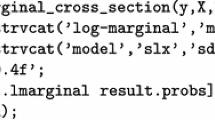Abstract
Applications of spatial probit regression models that have appeared in the literature have incorrectly interpreted estimates from these models. Spatially dependent choices frequently arise in various modeling scenarios, including situations involving analysis of regional voting behavior, decisions by states or cities to change tax rates relative to neighboring jurisdictions, decisions by households to move or stay in a particular location. We use county-level voting results from the 2004 presidential election as an illustrative example of some issues that arise when drawing inferences from spatial probit model estimates. Although the voting example holds particular intuitive appeal that allows us to focus on interpretive issues, there are numerous other situations where these same considerations come into play. Past work regarding Bayesian Markov Chain Monte Carlo estimation of spatial probit models from LeSage and Pace (Introduction to spatial econometrics. Taylor and Francis, New York, 2009) is used, as well as derivations from LeSage et al. (J R Stat Soc Ser A Stat Soc 174(4):1007–1027, 2011) regarding proper interpretation of the partial derivative impacts from changes in the explanatory variables on the probability of voting for a candidate. As in the case of conventional probit models, the effects arising from changes in the explanatory variables depend in a nonlinear way on the levels of these variables. In non-spatial probit regressions, a common way to explore the nonlinearity in this relationship is to calculate “marginal effects” estimates using particular values of the explanatory variables (e.g., mean values or quintile intervals). The motivation for this practice is consideration of how the impact of changing explanatory variable values varies across the range of values encompassed by the sample data. Given the nonlinear nature of the normal cumulative density function transform on which the (non-spatial) probit model relies, we know that changes in explanatory variable values near the mean may have a very different impact on decision probabilities than changes in very low or high values. For spatial probit regression models, the effects or impacts from changes in the explanatory variables are more highly nonlinear. In addition, since spatial models rely on observations that each represent a location or region located on a map, the levels of the explanatory variables can be viewed as varying over space. We discuss important implications of this for proper interpretation of spatial probit regression models in the context of our election application.







Similar content being viewed by others
Notes
Specifically, the model that is implied by this type of omitted variable bias is referred to as the spatial Durbin probit model.
The term autoregressive refers to any spatial econometric model that includes a spatially lagged y variable (i.e., Wy) which includes the spatial autoregressive probit model, the spatial Durbin probit model, and their variants.
Of course, Albert and Chib (1993) did not deal with the case of spatial dependence, so \(\rho =0\) in their independent probit model.
Here again, the general definition of \(X \beta \) should be kept in mind, which would lead to a modification of \(\beta _v\) to \((\beta _v + W \theta _v)\) in expression (5) for the case of the SDM model.
For the case of the SDM model, \(\beta _v\) would be replaced by \((\beta _v + W \theta _v)\), as noted previously.
Again, our notation \(X \hat{\beta }= \sum _{v=1}^{k} (x_{v} \hat{\beta }_{v} +Wx_{v} \hat{\theta }_{v})\) is quite general and can also be used for the case of the SDM model.
Higher-order neighbors are neighbors to the neighbors, neighbors to these neighbors, and so on.
References
Albert JH, Chib S (1993) Bayesian analysis of binary and polychotomous response data. J Am Stat Assoc 88(422):669–679
Autant-Bernard C, LeSage JP (2011) Quantifying knowledge spillovers using spatial econometric models. J Reg Sci 51(3):471–496
Caleiro A, Guerreiro G (2005) Understanding the election results in Portugal, a spatial econometrics point of view. Port Econ J 4(3):207–228
Crowley GR (2012) Spatial dependence in constitutional constraints: the case of US states. Const Polit Econ 23:134–165
Fiva J, Rattso J (2007) Local choice of property taxation: evidence from Norway. Public Choice 132(3):457–470
Fotheringham AS, Brunsdon C, Charlton M (2002) Geographically weighted regression: the analysis of spatially varying relationships. Wiley, West Sussex
Gelfand AE, Smith AFM (1990) Sampling-based approaches to calculating marginal densities. J Am Stat Assoc 85(410):398–409
Hall JC, Ross JM (2010) Tiebout competition, yardstick competition, and tax instrument choice: evidence from Ohio school districts. Public Finance Rev 38(6):710–737
Lacombe DJ, Shaughnessy TM (2007) Accounting for spatial error correlation in the 2004 presidential popular vote. Public Finance Rev 4(35):480–499
Leeson PT, Dean AM (2009) The democratic domino theory: an empirical investigation. Am J Polit Sci 53(3):533–551
LeSage JP, Pace RK (2009) Introduction to spatial econometrics. Taylor and Francis, New York
LeSage JP, Kelley Pace R, Lam N, Campanella R, Liu X (2011) New Orleans business recovery in the aftermath of Hurricane Katrina. J R Stat Soc Ser A Stat Soc 174(4):1007–1027
O’Loughlin J, Flint C, Anselin L (1994) The geography of the Nazi vote: context, confession, and class in the Reichstag election of 1930. Ann Assoc Am Geogr 84(3):351–380
Rincke J (2006) Policy innovation in local jurisdictions: testing for neighborhood influence in school choice policies. Public Choice 129(1–2):189–200
Seldadyo H, Elhorst JP, De Haan J (2010) Geography and governance: does space matter? Pap Reg Sci 89(3):625–640
Smith TE, LeSage JP (2004) A Bayesian probit model with spatial dependencies. In: LeSage JP, Kelley PP (eds) Spatial and spatiotemporal econometrics. Advances in econometrics, vol 18. Emerald Group Publishing Limited, Bingley, pp 127–160
Acknowledgements
James P. LeSage would like to acknowledge support for this research provided by the National Science Foundation, SES-0729264 and BCS-0136229. The statements, findings, conclusions, and recommendations are those of the authors and do not necessarily reflect the views of the National Science Foundation.




